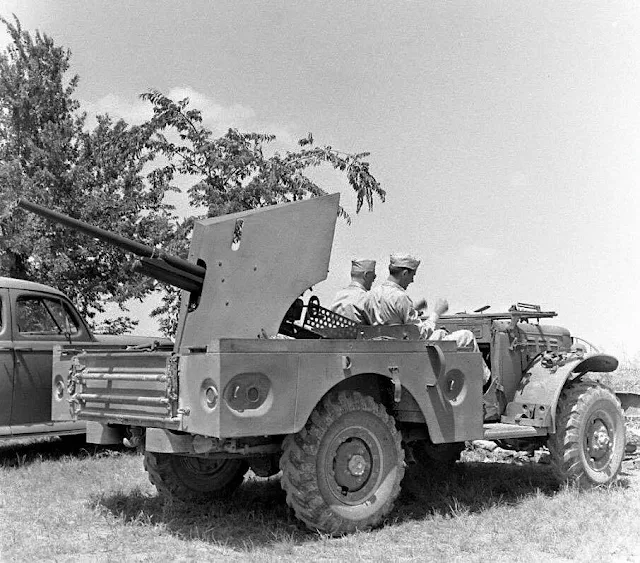 |
| M7 Medium Tank produced at International Harvester's Bettendorf Works. Only seven of these tanks were ever delivered to the military. 1942. |
The Medium Tank M7 was originally conceived as an up-gunned
replacement for the Light Tank M3/M5. The project was supposed to mount the
same 75mm armament as the M4 Sherman while retaining the light weight and
maneuverability of the M3 Stuart; however, during development the weight of the
prototype surpassed the US Army's standard for light tanks and crossed into the
medium category. The M7 had significantly less armor than the M4 Sherman,
boasted no greater firepower, and held only a slight advantage in top speed.
For these reasons, and because the M4 was already battle-tested and in full
production, the M7 was put aside shortly after completing trials.
On January 1941, the Armored force prepared a list of
characteristics for a new light tank. It was assigned the designation T7.
During the development program, its weight increased from 14 to almost 27 tons.
A more apt classification was thus given by OCM 18522, dated 6 August 1942,
which standardized the T7E5 as the M7 medium.
Test revealed that the produced vehicles were heavier than
anticipated at 28 to 29 tons fully stowed. This reduced performance and
production was halted until it could be rectified. Analysis of the problem
indicated that it was caused by castings being thicker than specified. Six of
the production tanks were then modified to use the lightest castings possible
and their power trains were revised to improve performance. The modified
vehicles were referred to as M7E2s in some documents. Testing of the modified
vehicles revealed improved performance but only at lower speeds and that the
performance was considered inferior to the M4A3 medium tank. The 6 modified
vehicles and the remaining 7 were accepted as M7 mediums bringing the total run
to 13 tanks. Thus production acceptance records show only a total of 7 tanks.
Specifications
Type: Medium tank
Place of origin:
United States
Manufacturer:
International Harvester Corp.
Produced: 1942
Number built: 7
Weight: 53,950 lb
(24,470 kg)
Length: 17 ft 2
in (5.23 m)
Width: 9 ft 4 in
(2.84 m)
Height: 7 ft 9 in
(2.36 m)
Crew: 5
(Commander, loader, gunner, driver, co-driver)
Armor: 13–64 mm
(0.51–2.52 in)
Main armament: 75
mm M3 in M47 mount; 71 rounds
Secondary armament:
3 × .30-06 Browning M1919A4 MG; 4,500 rounds
Engine:
Continental R975-C1; 9 cylinder, 4 cycle, radial gasoline; 350 hp (260 kW)
Suspension:
Vertical volute spring
Speed: 30 mph (48
km/h) on road
Variants
T7: Welded hull,
five speed Hydramatic transmission, volute spring suspension
T7E1: Riveted
hull, formed homogenous plate turret, torque converter
T7E2: Cast upper
hull, Wright R-975 Engine, Warner Gear torque converter, armed with Ordnance QF
6-pounder Mark III
T7E3: Welded hull
and turret, twin Hercules DRXBS diesel engines, Detroit Gear automatic
transmission
T7E4: Welded hull
and turret, twin Cadillac engines, two Hydramatic transmissions
T7E5: T7E2 rearmed with 75 mm M3 standardized as M7 medium
 |
| M7 Medium Tank. |
 |
| M7 Medium Tank. |
 |
| M7 Medium Tank. |
 |
| Partially assembled and completed M7 Medium Tanks at International Harvester's Bettendorf Works. 22 March 1943. |
 |
| Partially assembled M7 Medium Tanks at International Harvester's Bettendorf Works, 22 March 1943. |
 |
| Partially assembled M7 Medium Tanks at International Harvester's Bettendorf Works. 22 March 1943. |
 |
| M7 Medium Tanks in storage on the shipping dock at International Harvester's Bettendorf Works. 22 March 1943. |
 |
| Interior of the tank arsenal at International Harvester's Bettendorf Works. 29 June 1942. |
 |
| M7 Medium Tanks built by International Harvester for the U.S. military. The tanks were produced at the Quad-Cities tank arsenal at International Harvester's Bettendorf Works. 1943. |
 |
| The T7E2 Light Tank, still armed with the 57mm gun. |
 |
| T7E2 Light Tank. |
 |
| M7 Medium Tank. |
 |
| T7E1 Light Tank with turret from M3 Medium Tank. |
 |
| Mockup of T7E1 Light Tank with turret from M3 Medium Tank. |
 |
| Mockup of T7E1 Light Tank with turret from M3 Medium Tank. |
 |
| T7E1 Light Tank with turret from M3 Medium Tank. |
 |
| T7E1 Light Tank with turret from M3 Medium Tank with drive train exposed. |
 |
| T7E1 Light Tank with turret from M3 Medium Tank with engine exposed. |
 |
| Comparison of side views of T7E1 Light Tank and mockup of T7E2 Light Tank. |
 |
| Comparison of front views of T7E2 Light Tank and T7E1 Light Tank. |
 |
| T7E2 Light Tank. |
 |
| M7 Medium Tank upper view with hatches opened. |
 |
| M7 Medium Tank upper view with hatches closed. |
 |
| Rear view of M7 Medium Tank. |
 |
| M7 Medium Tank. |
 |
| M7 Medium Tank right front view. |
 |
| M7 Medium Tank left rear view. |
 |
| M7 Medium Tank top view. |
















































